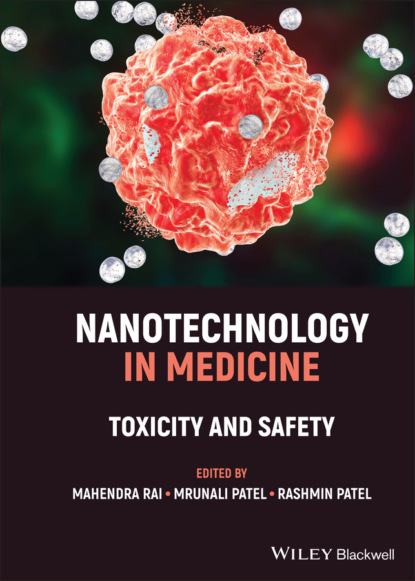in oncology. Journal of New Medical Technologies 27 (1): 81–86.
67 Shurygina, I.A., Shurygin, M.G., and Sukhov, B.G. (2016). Nanobiocomposites of metals as antimicrobial agents. In: Antibiotic Resistance: Mechanisms and New Antimicrobial Approaches (eds. M. Rai and K. Kon), 167–186. Academic Press.
68 Shurygina, I.A., Shurygin, M.G., Zelenin, N.V., and Ayushinova, N.I. (2017). Influence on mitogen‐activated protein kinases as a new direction of connective tissue growth regulation. Bulletin of Siberian Medicine 16 (4): 86–93.
69 Shurygina, I.A., Sosedova, L.M., Novikov, M.A. et al. (2018). Ecotoxicity of nanometals: the problems and solutions. In: Nanomaterials: Ecotoxicity, Safety, and Public Perception (eds. M. Rai and J. Biswas), 95–117. Springer.
70 Singh, N., Manshian, B., Jenkins, G.J.S. et al. (2009). NanoGenotoxicology: the DNA damaging potential of engineered nanomaterials. Biomaterials 30 (23–24): 3891–3914.
71 Skalickova, S., Milosavljevic, V., Cihalova, K. et al. (2017). Selenium nanoparticles as a nutritional supplement. Nutrition 33: 83–90.
72 Sukhov, B.G., Ganenko, T.V., Pogodaeva, N.N. et al. (2017). Agent with antitumor activity based on arabinogalactan nanocomposites with selenium and methods for prepariation of such nanobiocomposites. RU patent 2614363.
73 Sun, D., Liu, Y., Yu, Q. et al. (2013). The effects of luminescent ruthenium (II) polypyridyl functionalized selenium nanoparticles on bFGF‐induced angiogenesis and AKT/ERK signaling. Biomaterials 34: 171–180.
74 Sun, F., Wang, J., Wu, X. et al. (2019). Selenium nanoparticles act as an intestinal p53 inhibitor mitigating chemotherapy‐induced diarrhea in mice. Pharmacological Research 149: 104475.
75 Tan, H.W., Mo, H.Y., Lau, A.T.Y., and Xu, Y.M. (2019). Selenium species: current statusand potentials in cancer prevention and therapy. International Journal of Molecular Sciences 20 (1): 75.
76 Triantis, T., Troupis, A., Gkika, E. et al. (2009). Photocatalytic synthesis of Se nanoparticles using polyoxometalates. Catalysis Today 144 (1): 2–6.
77 Trukhan, I.S., Dremina, N.N., Lozovskaya, E.A., and Shurygina, I.A. (2018). Assessment of potential cytotoxicity during vital observation at the BioStation CT. Acta Biomedica Scientifica 3 (6): 48–53.
78 Tugarova, A.V. and Kamnev, A.A. (2017). Proteins in microbial synthesis of selenium nanoparticles. Talanta 174: 539–547.
79 Vekariya, K.K., Kaur, J., and Tikoo, K. (2012). ERα signaling imparts chemotherapeutic selectivity to selenium nanoparticles in breast cancer. Nanomedicine: Nanotechnology, Biology and Medicine 8 (7): 1125–1132.
80 Vinceti, M., Filippini, T., Cilloni, S. et al. (2017). Health risk assessment of environmental selenium: emerging evidence and challenges. Molecular Medicine Reports 15: 3323–3335.
81 Wadhwani, S.A., Shedbalkar, U.U., Singh, R., and Chopade, B.A. (2016). Biogenic selenium nanoparticles: current status and future prospects. Applied Microbiology and Biotechnology 100 (6): 2555–2566.
82 Wang, H., Zhang, J., and Yu, H. (2007). Elemental selenium at nano size possesses lower toxicity without compromising the fundamental effect on selenoenzymes: comparison with selenomethionine in mice. Free Radical Biology and Medicine 42: 1524–1533.
83 Wang, Y., Chen, P., Zhao, G. et al. (2015). Inverse relationship between elemental selenium nanoparticle size and inhibition of cancer cell growth in vitro and in vivo. Food and Chemical Toxicology 85: 71–77.
84 Wu, H., Li, X., Liu, W. et al. (2012). Surface decoration of selenium nanoparticles by mushroom polysaccharides–protein complexes to achieve enhanced cellular uptake and antiproliferative activity. Journal of Materials Chemistry 22: 9602.
85 Wu, T. and Tang, M. (2018). Review of the effects of manufactured nanoparticles on mammalian target organs. Journal of Applied Toxicology 38 (1): 25–40.
86 Xu, B., Zhang, Q., Luo, X. et al. (2020). Selenium nanoparticles reduce glucose metabolism and promote apoptosis of glioma cells through reactive oxygen species‐dependent manner. Neurorepeort 31 (3): 226–234.
87 Yanhua, W., Hao, H., Li, Y., and Zhang, S. (2016). Selenium‐substituted hydroxyapatite nanoparticles and their in vivo antitumor effect on hepatocellular carcinoma. Colloids and Surfaces. B, Biointerfaces 140: 297–306.
88 Yu, B., You, P., Song, M. et al. (2016). A facile and fast synthetic approach to create selenium nanoparticles with diverse shapes and their antioxidation ability. New Journal of Chemistry 40: 1118–1123.
89 Yu, B., Zhang, Y., Zheng, W. et al. (2012). Positive surface charge enhances selective cellular uptake and anticancer efficacy of selenium nanoparticles. Inorganic Chemistry 51 (16): 8956–8963.
90 Zhang, J., Wang, H., Bao, Y., and Zhang, L. (2004). Nano red elemental selenium has no size effect in the induction of seleno‐enzymes in both cultured cells and mice. Life Sciences 75: 237–244.
91 Zhang, J., Wang, H., Yan, X., and Zhang, L. (2005). Comparison of short‐term toxicity between Nano‐Se and selenite in mice. Life Sciences 76 (10): 1099–1109.
92 Zhang, J.S., Gao, X.Y., Zhang, L.D., and Bao, Y.P. (2001). Biological effects of a nano red elemental selenium. Biofactors 15 (1): 27–38.
93 Zhang, Y., Li, X., Huang, Z. et al. (2013). Enhancement of cell permeabilization apoptosis‐inducing activity of selenium nanoparticles by ATP surface decoration. Nanomedicine: Nanotechnology, Biology and Medicine 9 (1): 74–84.
94 Zhang, Z., Du, Y., Liu, T. et al. (2019). Systematic acute and subchronic toxicity evaluation of polysaccharide‐protein complex‐functionalized selenium nanoparticles with anticancer potency. Biomaterials Science 7 (12): 5112–5123.
95 Zhao, G., Wu, X., Chen, P. et al. (2018). Selenium nanoparticles are more efficient than sodium selenite in producing reactive oxygen species and hyper‐accumulation of selenium nanoparticles in cancer cells generates potent therapeutic effects. Free Radical Biology and Medicine 126: 55–66.
96 Zijlstra, A. and Vizio, D.D. (2018). Size matters in nanoscale communication. Nature Cell Biology 20 (3): 228–230.
Конец ознакомительного фрагмента.
Текст предоставлен ООО «ЛитРес».
Прочитайте эту книгу целиком, купив полную легальную версию на ЛитРес.
Безопасно оплатить книгу можно банковской картой Visa, MasterCard, Maestro, со счета мобильного телефона, с платежного терминала, в салоне МТС или Связной, через PayPal, WebMoney, Яндекс.Деньги, QIWI Кошелек, бонусными картами или другим удобным Вам способом.
